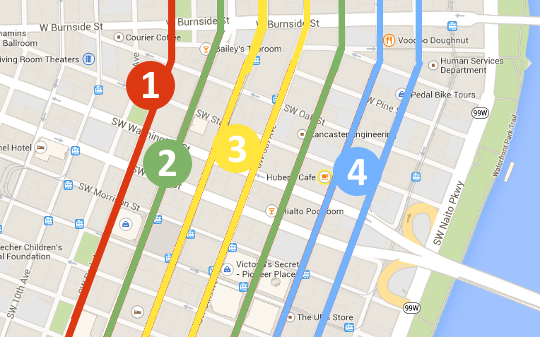Third in a week-long series about the BTA’s five new advocacy campaigns.
With almost every street project that isn’t happening in Portland, the city’s stated reason is that it doesn’t have the money. A long-discussed couplet of north/south protected bike lanes through downtown is the exception.
As we’ve been reporting, the city has enough money lined up, thanks to a $6.6 million Metro grant for downtown active transportation improvements that took years to secure. What’s still missing is political support.
The Bicycle Transportation Alliance launched a campaign this month aimed at lining up that support among “civic, business and elected leaders.”
BTA Advocacy Director Gerik Kransky said that even though downtown is far and away the most popular destination for bike-commuting, it’s a yawning gap in the city’s network of low-stress bike routes.

“You get into downtown and it’s gone — there’s nothing left,” Kransky said in an interview. “Though we’ve got the wide painted bike lanes on southwest Stark and Oak running east-west, we don’t have a corollary facility running north and south through the central city.”
“I think it’s an opportunity for us to make a big bold political statement about committing space on a major thoroughfare to bikes,” Kransky said.
Which major thoroughfares, exactly? That’s still an open question.
Routes still being decided

(Photos: M.Andersen/BikePortland)
At the BTA’s members meeting this month, people who stopped by Kransky’s table had a chance to vote on their favorite route for a north/south couplet: 2nd/3rd, 4th/Broadway, 5th/6th or the park blocks (presumably 8th, 9th and/or Park).
Another possibility might be a bidirectional bike lane on only one of those streets, similar to the design Seattle is about to open on its 2nd Avenue downtown. About a third of the country’s 164 protected bike lanes are bidirectional, almost all of them on one-way streets.
Advertisement
At the BTA meeting, a 4th/Broadway couplet was far and away the popular favorite, in part because Kransky was (as he put it) shamelessly arguing that it’s the ideal route, thanks to its connection to the existing protected lane on Broadway near Portland State University, the existing buffered lane on the west landing of the Broadway Bridge and potentially the N/NE Broadway protected lane that the BTA is also gathering support to build.
Meanwhile, a group of Old Town businesses has been urging the city to consider protected lanes on 2nd and 3rd Avenues to reduce speeding and car/pedestrian conflicts on those streets.
Kransky said one of his main concerns is that the city will use a paint-only design that doesn’t actually prevent motor vehicles from encroaching or parking on the bike lanes.
“You could imagine a world where you could create a paint buffer, a la Broadway at Portland State University, for pennies and then there’d be a lot of money for other stuff,” Kransky said. “There’s a lot of money there, and what we would like to make sure is that we get a truly world-class facility built. I would imagine we’re going to need most of that money if not more.”
On the other hand, Kransky said it’s reasonable for the city to dedicate some of its $6.6 million budget to planning and community outreach.
“One of the lessons that I learned from the failure of the 20s Bikeway conversation … was that the city didn’t necessarily have the right approach when it comes to community engagement,” Kransky said.
Quick take: BikePortland’s summary of the project
Where the idea came from: Dan Bower, the former manager for the city’s active transportation division, was the longtime point person on this project, which has been seen as a complement to another project he spearheaded: a public bike sharing system. Bower left the city last spring, after securing funding for both projects. They’ve been on the city’s back burner since.
What it might cost: A bike lane that’s elevated from the roadway, as in Copenhagen or Indianapolis, might cost $16 million to $50 million for two miles (one mile north, one mile south). Planters or concrete curbs, as in Seattle or Vancouver BC, would cost less than a million, but more if dedicated bike signals were added.
Obstacles: If either Broadway or 6th is involved, downtown hotels are certain to be concerned about front-door access for taxis and customers. Last year, the Portland Business Alliance successfully opposed converting a general traffic lane to a bike lane on Southwest 12th Avenue, a street that rarely sees any congestion. For this project to work, the plan will need to address block-by-block design complications and also contain some antidote to the notion that the most valuable street is one that can carry and park as many cars as possible.
Finally, the Portland city council seems deeply reluctant to do anything that might improve biking — and thereby attract the ire of people who oppose biking improvements — until a new citywide transportation fee or tax is approved. “My read on the politics is the street fee has to come first,” Kransky said.
Likely tradeoffs: Either a parking lane or a general travel lane, maybe more, on any affected street. At least a few parking spaces would probably have to go away for the sake of improving visibility. If the lanes were to go on 5th/6th, the change would be simple — no car turns onto the transit mall — but might draw more opposition.
How you could help: The BTA isn’t really asking for much help on this campaign at this point. It’s circulated a petition in print but hasn’t yet posted an online version. “The most important thing would be standing up in support of cycle tracks, period,” Kransky said.
Check back each day this week for another post in our series about new advocacy campaigns.



